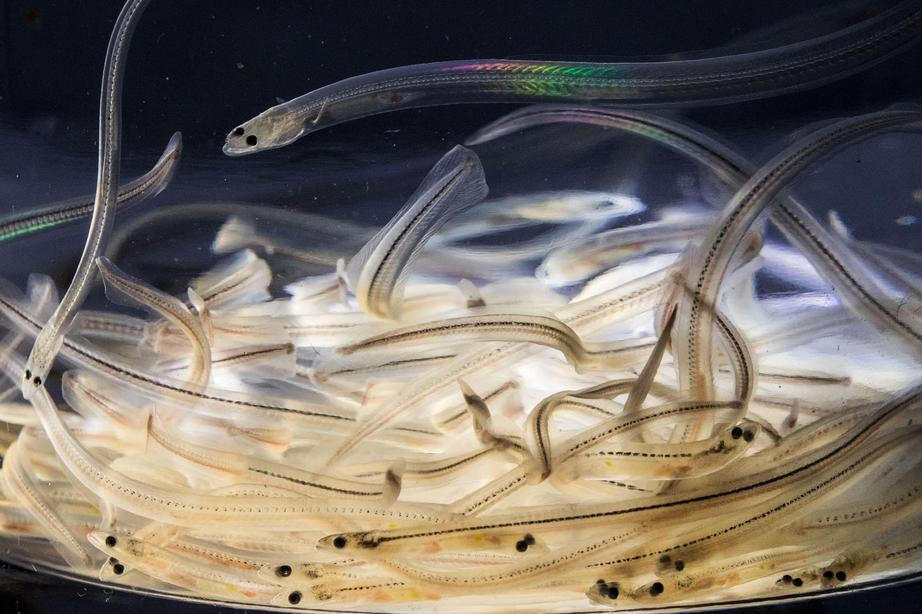Inside the multimillion-dollar world of eel trafficking
Agents with the U.S. government’s ‘Operation Broken Glass’ have nabbed more than a dozen men for smuggling valuable baby eels to Asia.
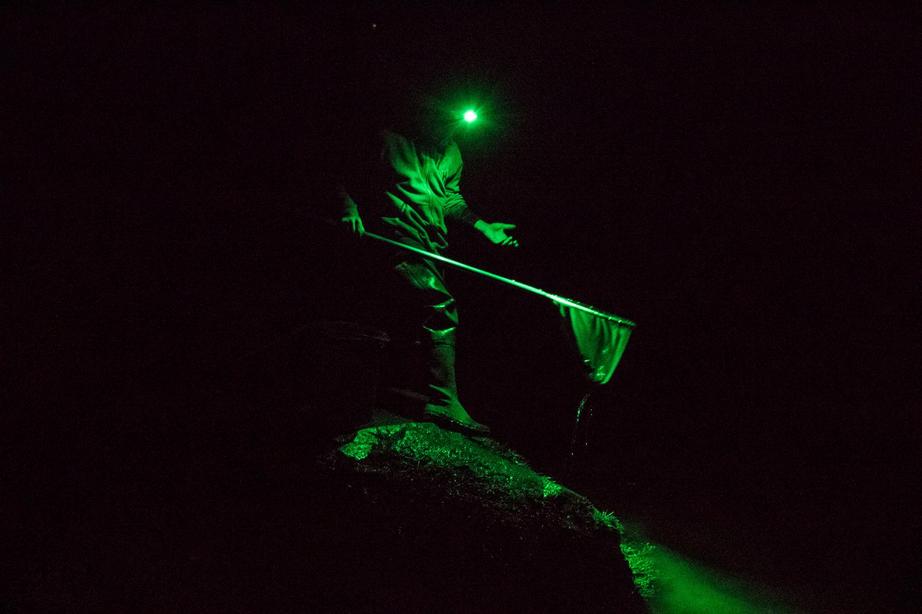
Alvah Wendell, 43, rhythmically swishes his dip net to catch young eels as they swim up the Bagaduce River in Maine. He uses a green headlamp because white light spooks the fish. “You don’t need to see them to catch them,” he says. “But I like to watch.”
Photograph by Sarah Rice, National Geographic
The alleged kingpin of one of the biggest domestic wildlife smuggling operations ever to hit the East Coast is exactly where you’d expect to find him on a rainy evening in early May: firmly planted in a swivel chair at a big green metal desk inside his renovated Quonset hut on Foster Street, in Ellsworth, Maine.
At this post Bill Sheldon waits day and night for fishermen to come and fill his bowl with writhing masses of baby eels.
The 72-year-old fisherman wears glasses, a blue flannel shirt, jeans, duck boots, and a brown L.L. Bean baseball cap. His cell phone goes quack, quack, quack when it rings. The sign above his head reads, “Buying Glass Eels Here,” with the day’s market price: $1,250 per pound. The eel bowl sits atop a digital scale on a small, four-legged table. Nearby a scented candle burns in a glass jar (“to cut the fish smell”).
Grandfatherly and laid-back, Sheldon doesn’t look the part of a serious criminal. But on March 30, one week after the start of Maine’s 10-week-long eel fishing season, Sheldon and another man, Timothy Lewis, were indicted for illegally trafficking wildlife. They pleaded not guilty.
According to court documents, Lewis, 46, is charged with two felonies involved with conspiring to unlawfully launder eels up and down the East Coast. Sheldon, who operated a business called Kennebec Glass Eels at his home in Woolwich, a motel in Ellsworth, and a rental house in Moncks Corner, South Carolina, is up against more serious charges: seven counts of conspiracy to smuggle eels while violating laws in seven states (Maine, New Jersey, Delaware, Virginia, Massachusetts, North Carolina, and South Carolina).
For each felony Sheldon faces a maximum sentence of a $250,000 fine and up to five years in prison, as well as the forfeiture of any related vessels, equipment, and vehicles, including a black 2012 Ford F450 with the license plate EELWGN. (He preemptively sold the truck but kept the vanity plate.) Sheldon and Lewis are scheduled for separate hearings in July.
For now Sheldon is free to buy eels for a newly formed company, Maine Eel Trade & Aquaculture, which opened in 2015, with purchasing locations in Waldoboro, Portland, Steuben, and the Quonset hut in Ellsworth.
He isn’t keen to have a journalist hanging around asking questions about his indictment, but he allows me to pull up a chair at the desk where he punches numbers on a large calculator and works on a black laptop. The table holds an old Velvet pipe and cigarette tobacco can and a sizable ashtray.
The room is filled with the thrum of water bubbling in large blue aerated tanks containing thousands of two-inch-long translucent baby eels—“glass eels”—which look like Thai noodles. Every few days the tanks get trucked to a location where the eels are packed in clear plastic bags filled with oxygenated water and boxed by the kilo.
Agents with the U.S. Fish and Wildlife Service inspect perhaps one in four of the eel boxes, looking for hidden animals, before they’re shipped to Asia to be raised on giant aquaculture farms.
Within a year, when the farmed eels reach about a foot long, they’re harvested and prepared—split down the back, gutted, deboned, butterflied, cut into square fillets, skewered, dipped in a sweet soy sauce, and grilled. Then they’re vacuum- packed and exported to be served, as unagi, at sushi joints all over the world, including the United States.
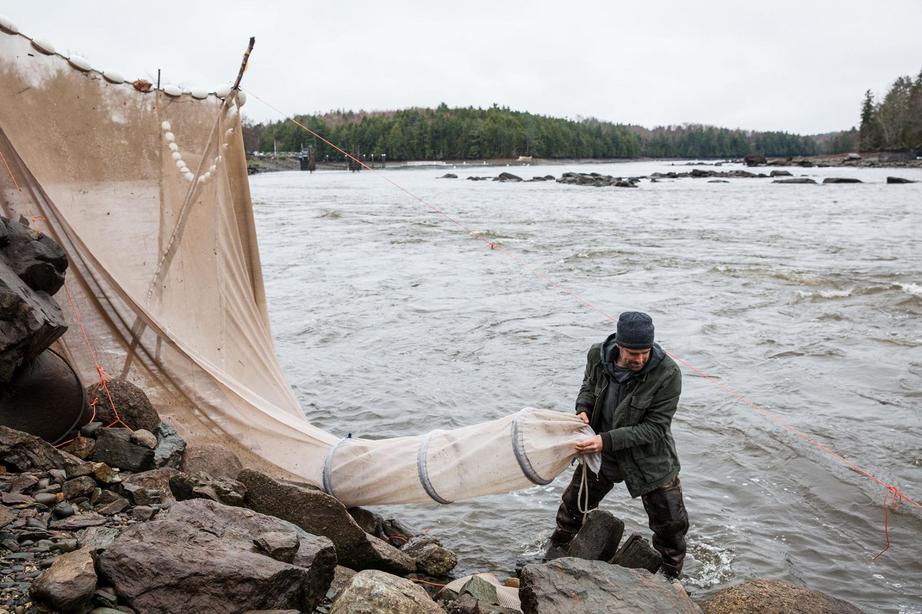
Adam Dragon checks his fyke net on the Union River in Ellsworth, Maine, twice daily at low tide. The net’s opening faces downstream to catch eels in the long funnel, known as the tail sac or cod end.
Photograph by Sarah Rice, National Geographic
MYSTERY FISH
The American eel, Anguilla rostrata, is one of 16 species in the Anguillidae family, arguably some of the most mysterious animals found in nature. Every year the sexually mature eels leave rivers draining into the Atlantic and swim all the way to the Sargasso Sea, a vast gyre in the vicinity of Bermuda, to spawn.
“If you drained all the water out of the Atlantic and kicked a beach ball, it would roll to the Sargasso—it’s a deep hole,” Sheldon says. “There’s something inside these eels that makes them go deeper and deeper until they all wind up there to spawn.” After they spawn, the adults die. No one has ever witnessed eels spawning.
The eel larvae—which resemble transparent, gelatinous willow leaves—drift with the Gulf Stream, scattering along coastlines from Venezuela to Greenland. The fish, glass eels by now, leave the ocean and swim upstream into the continent’s rivers. Hiding in the shadows of eelgrass beds, they grow fat and up to five feet long over 20 years or so before heading back to the Sargasso.
In the past, American eels—less desirable to Asian tastes than the Japanese and European species—represented a small fraction of total international sales. But in 2010 the European Union banned exports of European eels, which had been declared critically endangered, causing a sudden shortage. It was particularly acute in Japan, where people consume more than a hundred thousand tons of unagi a year and hold an annual eel-eating festival, Doyo no ushi no hi, in the height of summer.
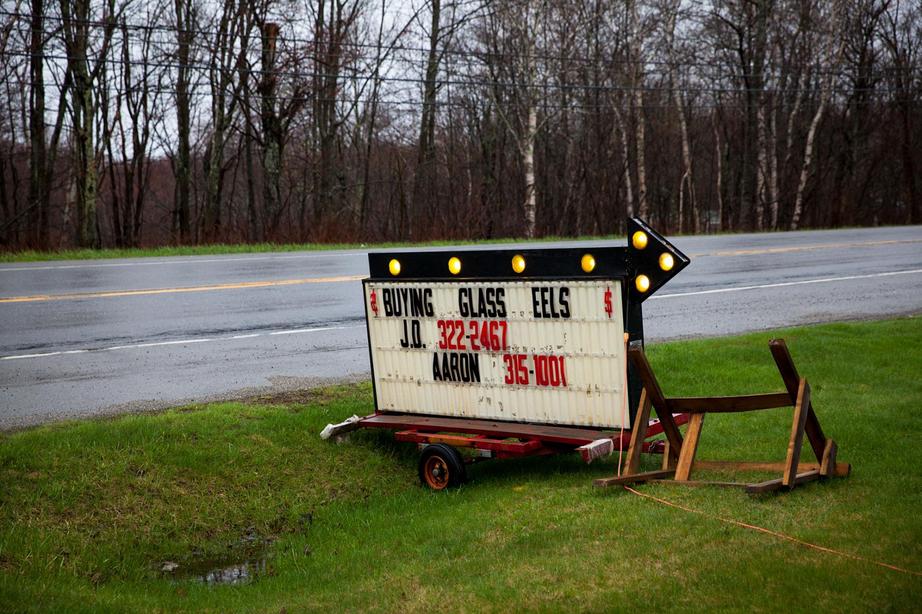
Fishermen can sell their eels 24/7 in Maine during the ten-week eel season.
Photograph by Sarah Rice, National Geographic
With the Japanese species also in steep decline, Asia turned to the U.S. for baby eels to seed aquaculture farms. By 2012 the price for the American species had skyrocketed to more than $2,000 a pound, creating an eel rush for fishermen in Maine. Guys who’d scraped by in the off-season doing construction jobs, painting houses, and collecting seaweed now raked in hundreds of thousands of dollars in the eel fishing season, which ends during the first week in June.
Today wild-born American eels raised in China appear on menus pretty much everywhere.
FATHER OF THE EEL FISHERY
Bill Sheldon’s Quonset shop was a little slow earlier this season following a story in the Bangor Daily News about his troubles with the Feds. Some locals were mad at him, complaining that he was giving Maine fishermen a bad name.
But respect for the father of the state’s eel fishery runs deep here. Sheldon’s been in the eel buying business for about 20 years, and for more than twice that long he’s taught lobstermen and clam diggers how to catch the slippery fish.
He’s loaned fishermen money for specially designed $1,000 fyke nets set at night at low tide that guide eels swimming upstream into a cone-shaped trap, and he’s paid more than $2,000 a pound for eels in some years. According to Sheldon, in 2012 alone those payments pumped $12 million into the local economy.

Some fishermen talk about “the wave,” when eels migrate en masse upriver making a din that sounds like a fizzing soda drink.
Photograph by Sarah Rice, National Geographic
Maine’s glass eel industry got its start with a phone call in 1970 from an American fishery attaché in Tokyo to a freshly minted graduate in wildlife management—Sheldon—working at the Maine Department of Marine Resources.
The attaché, Sheldon recalls, said the Japanese were “looking for a supply of baby eels. ‘Do you know anywhere in Maine where there are enough baby eels to start a commercial fishery?’ I said, ‘Do we got baby eels? Yeah, we’ve got tons of ’em.’”
Sheldon spent the spring of ’71 documenting abundant eels in the Kennebec, Penobscot, and St. Croix Rivers—and in every brook he checked in the area. The following spring he turned to figuring out how to catch them. “A handheld dip net was perfect,” he says. “I also came up with a trap—it’s known as the Sheldon trap—made of two window screens and a box.”
Two years later he wrote a seminal paper on young eels in Maine. But then Sheldon quit his state job and became a lobster buyer. “I didn’t have any interest in eels. So I passed my knowledge on to a man named Randall Livingston in South Carolina—he was the first commercial eel buyer in this country.”
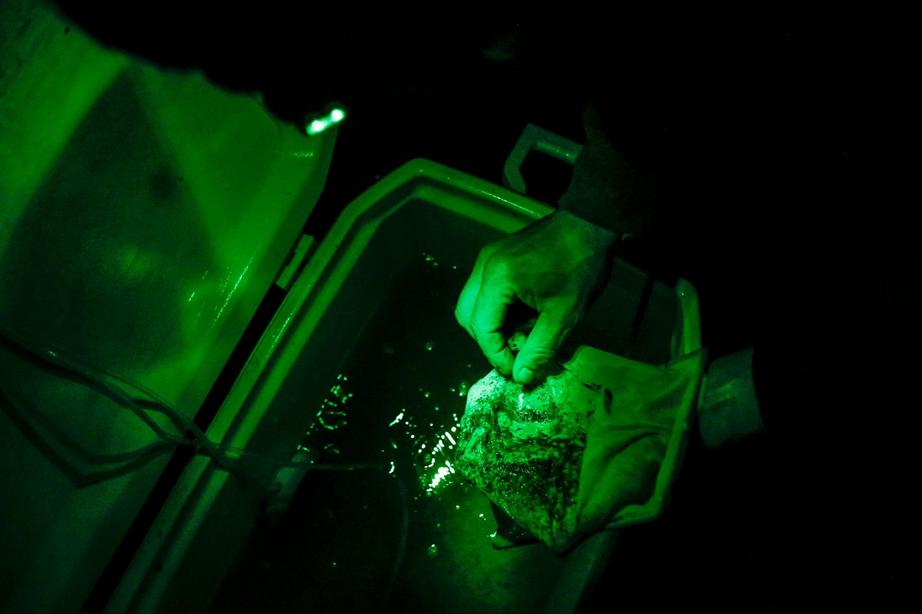
Dip netters work on rocky shorelines all night, every night until they reach their individual annual quotas, which can range from 4 pounds to 150 pounds.
Photograph by Sarah Rice, National Geographic
Sheldon worked as a lobster buyer for 25 years until March 19, 1990. That’s when his $250,000 boat crashed into a ledge and sank, without insurance. Now he needed a job. “I called Randall. ‘This is Bill Sheldon. I’m on hard times. Can you put me on your eel crew?’ He said, ‘Sure!’”
At that time you could catch eels legally anywhere along the East Coast, and Randall’s crew chased the runs from Florida in January all the way to Maine in March. “We would meet in New York with tank trucks full of eels, pack them in a warehouse, and ship them to Japan—everything went to Japan then,” Sheldon says.
By 2012 the price for the American species had skyrocketed, creating an eel rush for fishermen in Maine.
By the late 1990s eels were becoming less plentiful. Most states along the eastern seaboard had responded to concerns about overexploitation by shutting down their glass eel fisheries. Today glass eels can be taken only in South Carolina, which maintains a small fishery, Maine, where the annual quota is just under 10,000 pounds, and Florida, where eels are too scarce to support a fishery.
Maine fishermen say that quota is too strict, arguing that glass eels have a huge range along the entire East Coast and far beyond and that they’re harvesting only a sliver of that habitat. “Maine errs on the side of conservation,” Sheldon says, “but they’ve gone too far.”
THERE’S GOLD IN THEM THAR EELS
Everyone in Ellsworth has a story about the eel rush days of 2012.
Paul Dragon, 67, meets me at the door of his small log cabin wearing a green T-shirt, jeans, and white tube socks. He settles in his recliner chair near the woodstove and tells me what it was like for him. “You do get this gold fever,” he says. “One night I picked up $6,700 worth of eels, just this tired old guy with his dip net.”

Juvenile glass eels that survive to adulthood can reach five feet long and weigh up to nearly 20 pounds.
Photograph by Sarah Rice, National Geographic
Being a fisherman is brutal labor, Dragon says. “Most of the people who started glass eel fishing were worm diggers, clam diggers, and lobster fishermen. Then along came glass eel fishing. It was like the sun coming out from behind the clouds after this long rainy spell. It was so exciting.”
There were no catch limits, and it was legal for dealers to pay cash on the spot.
“Bill Sheldon would park down on Water Street in Ellsworth with a half a million dollars,” Dragon recounts. “Whenever they got low on money, they’d make a call, and someone would bring over another big bag of money. It was unbelievable what was going on—inconceivable.”
Sheldon hired a bodyguard named Larry Taylor, who keeps a Glock visible in his holster at all times to protect against thieves. Most other dealers armed up too.
Randy Bushey, a buyer in Steuben, about 45 minutes east of Ellsworth, remembers coming back from Bangor one morning around 2:30 going 65 miles an hour in a 45 zone. When he got pulled over, he told the cop he had weapons and a carrier’s permit.
“I had a .45-caliber handgun under my left arm, a .45 in the glove compartment, a 12-gauge shotgun between the seats, and by the way, a .22-caliber pistol on my belt buckle. The cop said, ‘Why do you have so many guns?’ I told him I had a hundred pounds of eels and more than a quarter million dollars in cash.”
Everyone was on edge, Bushey says. “There were rumors that gangs from New Jersey were coming to rob the Maine buyers. We were told, ‘If you see a bunch of guys with tattoos, shoot first and ask questions later.’ I think the fishermen were scared too. If I handed you $80,000 at midnight on a riverbank, what are you going to do? Run.”
Turf wars erupted between fishermen that ended in fistfights. Poachers donned scuba masks to reach restricted areas. And there were robberies. In 2013 an eel poacher named Alan Perkins broke into a local seafood business and tried to make off with a five-gallon bucket of glass eels worth $10,000. The business owners fought to capture him, but he got away. After a month-long manhunt, police finally hauled him into the Hancock County Jail. He was indicted on charges of burglary, theft, and violating release and was sentenced to seven years in jail.
Darrell Young, a stocky guy in a baseball hat and blue reflective sunglasses, tells me his story while chain-smoking Winstons in his white Dodge Power Wagon with flames on the back. Country music is on the radio, and an uneaten packaged doughnut sits on the center console.

There are roughly 2,000 glass eels to the pound. Boxes with up to a hundred pounds of them are shipped to Asia to be sold to aquaculture farms.
Photograph by Sarah Rice, National Geographic
“When I started fishing 25 years ago, the price of eel was $30 to $40 per pound,” he says. “We couldn’t even afford fyke nets, we were so poor. Guys would say, ‘I made enough to fill my refrigerator with food.’ Then in 2012,” Young continues, “I made $150,000. I paid everything off—my taxes, a $30,000 loan on my house, everything. In 2013 I made $200,000—that was another amazing year. I bought my boy a house.”
When the Atlantic States Marine Fisheries Commission, which coordinates the conservation and management of the eel fishery, started tightening restrictions in response to concerns about the resource, Young, who can’t read or write, founded the Maine Elver Fishermen’s Association. “The government was going to shut us down. That’s when I knew we had to get organized.”
Young traveled to Alexandria, Virginia, where the commission was holding a meeting in February 2014. “We went to fight for the industry and got slammed with a quota—11,749 pounds,” he says, flicking ash out the window. “Then we got cut again to 9,688 pounds.” A portion of that quota, about 21 percent in 2016, is shared with four local Native American tribes in recognition of their indigenous rights.
The way it works is that each fisherman has an annual allowable take based on the average of his or her past eel landings. Each time a fisherman sells eels, the tally is tracked with a swipe card that logs the information into a government database.
Another new rule: Dealers can no longer pay cash—only checks. That was a good change, Young says. “It was dangerous before. Thank God nothing ever happened.”
Young vows that he and the other fishermen will keep fighting further restrictions that may reduce their catch.
‘OPERATION BROKEN GLASS’
Around the time the commission was clamping down on the fishery, the federal government was mounting a multistate undercover investigation dubbed Operation Broken Glass to catch people operating an eel laundering and trafficking scheme up and down the East Coast.
Dealers were buying glass eels from places where it was illegal to fish them, trucking them to destinations where they could be mixed with legal eels, doctoring shipping dossiers, and exporting them to Asia.
On March 17, 2014, in Ruffin, South Carolina, Yarann Im, 35, purchased a package containing nearly eight pounds of eels from an undercover agent with the National Oceanic and Atmospheric Administration. Im handed the agent a check for $3,450. Three days later he exported that haul in a shipment of 38 pounds of eels—valued at $25,000—via Boston, Massachusetts, to an importer in Hong Kong.
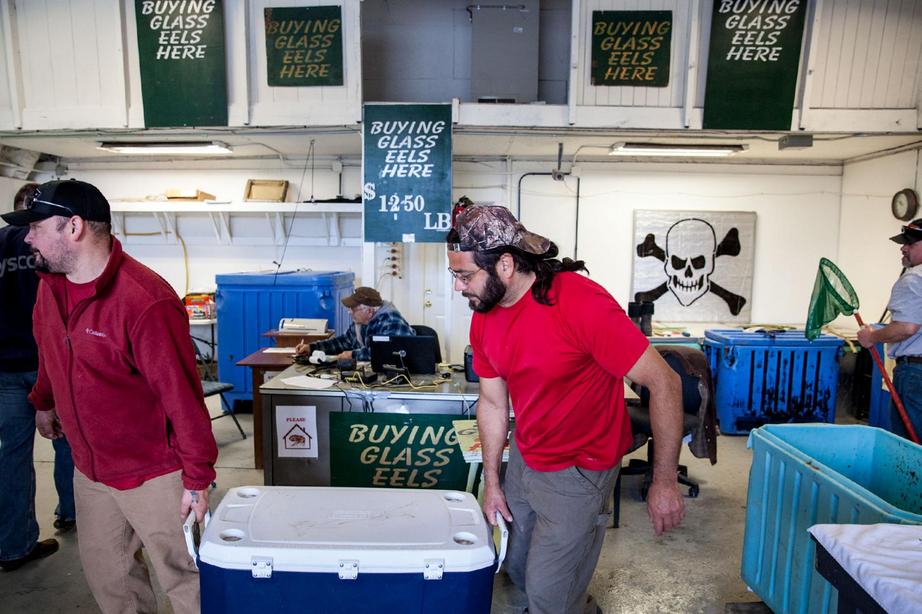
Fishermen Saul Love (left) and Joseph Dana visit Bill Sheldon’s shop toting a cooler loaded with glass eels.
Photograph by Sarah Rice, National Geographic
In the weeks that followed, Im made a series of subsequent purchases and shipments to China and elsewhere, reaping more than $500,000 in payments.
Im was among seven men who in October 2016 pleaded guilty in the federal district court in Portland, Maine, to trafficking a total of more than $1.9 million worth of glass eels in violation of the Lacey Act, a law passed in 1900 to protect wildlife by enforcing civil and criminal penalties for the illegal trade of animals and plants.
In November three more men pleaded guilty in South Carolina to selling and transporting more than $740,000 worth of glass eels obtained illegally in the state.
In early April of this year Brooklyn seafood dealer Tommy Zhou became the 11th person to plead guilty to eel trafficking. Using his Maine dealer license as cover for his illegal activity, Zhou had bought and exported more than $150,000 of glass eels harvested in Virginia.
More indictments could be coming, and federal agents involved in the case say they can’t speak about the status of the operation. “This is an ongoing investigation,” said David Sykes, resident agent in charge for the Fish and Wildlife Service’s New England Office of Law Enforcement.
EEL FARMING: THE FUTURE
At low tide, around 8:30 in the morning, under gray skies and a cold, misty rain, Paul Dragon’s son Adam unties the tail end of his fyke net and peers inside to see how many eels he caught during the night on the bank of the Union River, which runs through Ellsworth. The younger Dragon, 44, lean and nimble, with a salt-and-pepper scruffy chin, is wearing a green barn jacket, gray skullcap, and hip waders.
He shakes the squirming eels into a white bucket. “That’s much less than I caught the night before—maybe my second worst night,” he says. Still, there have been plenty of good nights to balance the bad. “When I caught three pounds last week, I was like, this is why I do this.” By his estimation three pounds represents perhaps 7,500 glass eels.
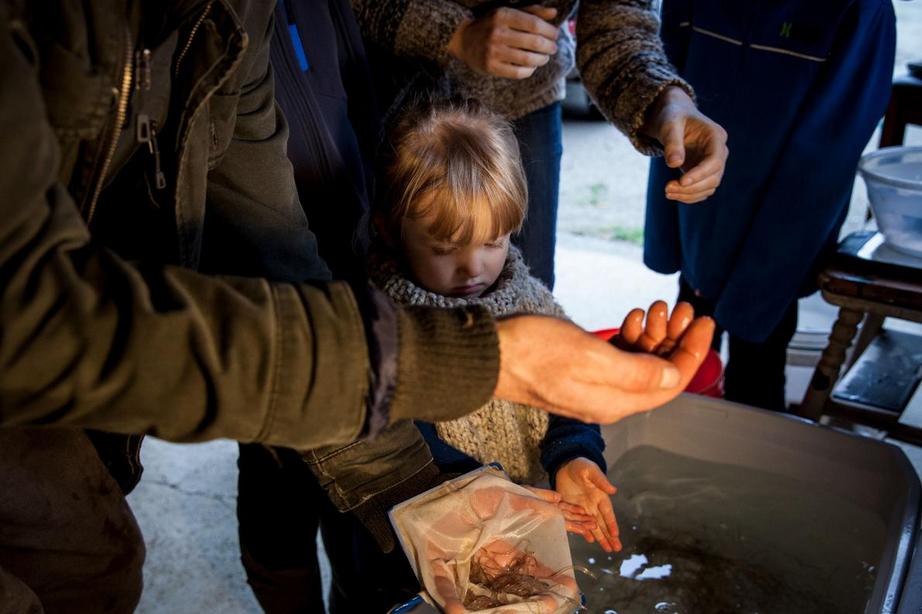
Adam Dragon’s daughter Maisy-Grace, two, is always eager for her dad to return home with a cooler full of eels. She says they’re “cute.”
Photograph by Sarah Rice, National Geographic
Adam has been working mainly with two dealers newer to the business than Sheldon, but when they fail to answer his calls, we drive over to the Quonset hut.
Sheldon twists the water out of the sack of slimy eels as if squeezing a pastry bag. He empties them into the metal bowl. Weight: 1.15 pounds. “These will be in China in five days,” he says. He enters the data on his computer. “Buyer: Bill Sheldon. Port: Ellsworth. Quantity: 1.150 lbs; PP: $1300/lb; Total $1,495.” He hands Adam a check.
“It took the risk out for the buyer,” Sheldon says of the decision to ban cash transactions. With a real-time record of all sales, law enforcement can monitor the whole process, through to delivery in Asia.
Sheldon and Adam Dragon are a generation apart, but they’re of the same mind when it comes to the future. “Our family would like to get involved in eel farming,” Adam says. “The dream is to catch, farm, and sell domestic.”
Demand for eel keeps growing, not only in Asia but all over the globe as the taste for sushi spreads. “The whole future of this industry is in eel farms,” Sheldon says. “Raise them here, and what we don’t consume, we put on the world market to sell to the same people we’re selling to now. It just makes so much sense.”
But there are hurdles. Aquaculture farms are expensive, and some farming methods common in Asia have not been approved in the U.S. For example, the use of hormones. Eels are intersexual, meaning they can become either male or female. The overcrowded conditions on the farms encourage a higher proportion of males, which weigh less and have no market value, so hormones are given to increase the number of females.

Eels were so plentiful this spring that midway through the season many Maine dip netters had already maxed out their quotas.
Photograph by Sarah Rice, National Geographic
“I’ll probably be dead and gone before aquaculture,” Sheldon says. “For now it makes sense to harvest and market them without destroying the fishery—it’s such a great fishery for the little man with a pair of boots and a dip net.”
Around the corner on strip-mall-studded High Street, adjacent to a Verizon store, is a sushi joint where you can buy an eel-cucumber roll for six dollars.
Does Sheldon like sushi? “I’m not a fan,” he says, scrunching his face. Then he reaches into the eel bowl, pinches a few live eels, and gulps them down. “Just like sushi! Try one,” he dares. “Longevity and wisdom.”
We all laugh. Then Sheldon turns somber. “I face some very serious charges,” he says. “But everyone deserves their day in court, and I ain’t had mine yet.”
For the rest of this article please go to source link below.
For full references please use source link below.

